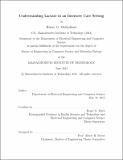| dc.contributor.advisor | Roger G. Mark. | en_US |
| dc.contributor.author | Mulholland, Hilary G. (Hilary Grace) | en_US |
| dc.contributor.other | Massachusetts Institute of Technology. Department of Electrical Engineering and Computer Science. | en_US |
| dc.date.accessioned | 2016-01-04T20:01:05Z | |
| dc.date.available | 2016-01-04T20:01:05Z | |
| dc.date.copyright | 2015 | en_US |
| dc.date.issued | 2015 | en_US |
| dc.identifier.uri | http://hdl.handle.net/1721.1/100638 | |
| dc.description | Thesis: M. Eng. in Computer Science and Molecular Biology, Massachusetts Institute of Technology, Department of Electrical Engineering and Computer Science, 2015. | en_US |
| dc.description | This electronic version was submitted by the student author. The certified thesis is available in the Institute Archives and Special Collections. | en_US |
| dc.description | Cataloged from student-submitted PDF version of thesis. | en_US |
| dc.description | Includes bibliographical references (pages 73-74). | en_US |
| dc.description.abstract | We investigated the relationship between initial lactate levels and ICU patient outcomes using the MIMIC II (version 2.6) database. We divided ICU admissions based on their initial lactate measurement into three groups: admissions with high lactate (above 4.0 mmol/L), admissions with medium lactate (between 2.0 mmol/L and 4.0 mmol/L), and admissions with low lactate (below 2.0 mmol/L). In addition to the ICU population as a whole, we studied sepsis patients using three different criteria (Martin, Angus, and infection with SIRS). We found that increased lactate levels were associated with a higher ICU mortality, higher 30 day mortality, longer ICU length of stay, and higher SOFA and SAPS I severity scores in all ICU admissions and in all three sepsis cohorts. Sepsis patients with high initial lactate levels were the most severely ill of all the patient populations. Sepsis patients identified with the Martin criteria who had high lactate levels had the worst outcomes of the three sepsis cohorts, but had similar average severity scores. This suggests that knowing lactate levels may give predictive value in addition to severity scores. We also investigated the relationship between initial lactate, change in lactate from the first measurement to the second measurement, and ICU mortality. We found that patients with high initial lactate levels in combination with an increase in lactate level typically had poorer outcomes than patients with high initial lactate levels with a decrease in lactate level. | en_US |
| dc.description.statementofresponsibility | by Hilary G. Mulholland. | en_US |
| dc.format.extent | 74 pages | en_US |
| dc.language.iso | eng | en_US |
| dc.publisher | Massachusetts Institute of Technology | en_US |
| dc.rights | M.I.T. theses are protected by copyright. They may be viewed from this source for any purpose, but reproduction or distribution in any format is prohibited without written permission. See provided URL for inquiries about permission. | en_US |
| dc.rights.uri | http://dspace.mit.edu/handle/1721.1/7582 | en_US |
| dc.subject | Electrical Engineering and Computer Science. | en_US |
| dc.title | Understanding lactate in an intensive care setting | en_US |
| dc.type | Thesis | en_US |
| dc.description.degree | M. Eng. in Computer Science and Molecular Biology | en_US |
| dc.contributor.department | Massachusetts Institute of Technology. Department of Electrical Engineering and Computer Science | |
| dc.identifier.oclc | 933234278 | en_US |
